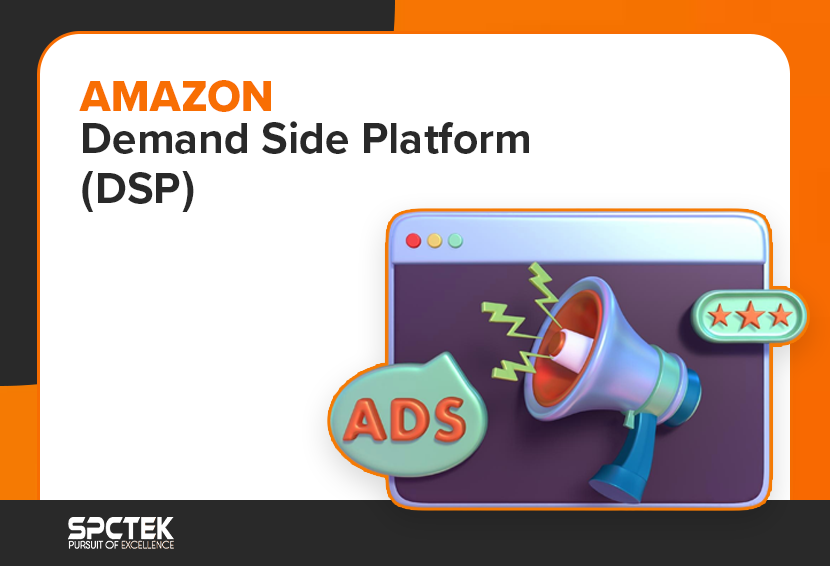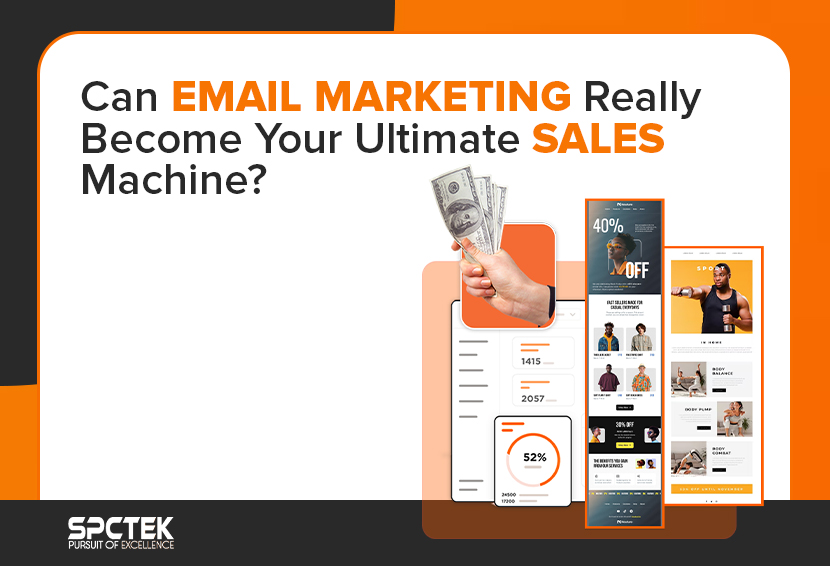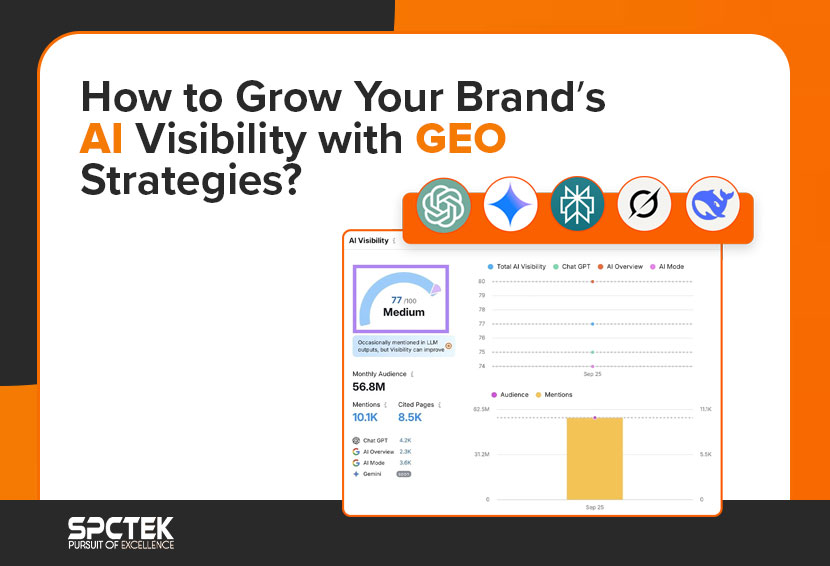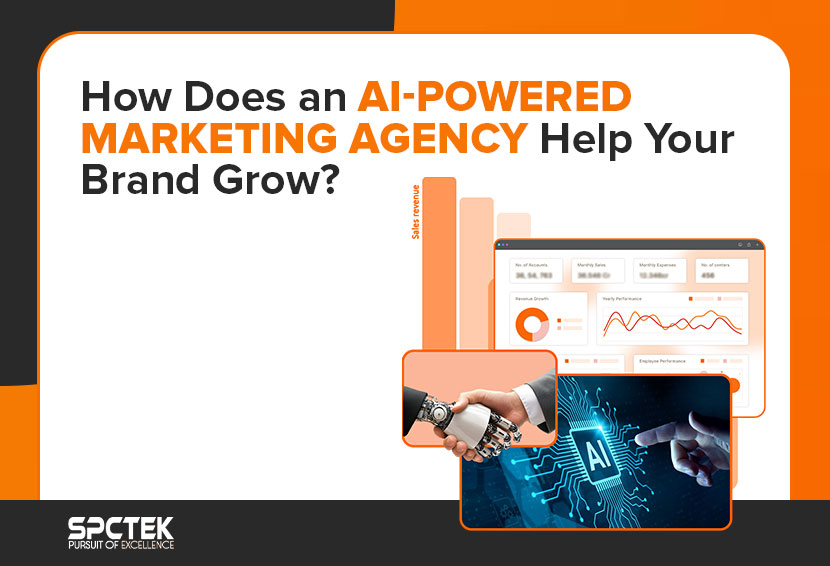If you want to get real results from your online ads, it’s important to reach the right people at the right time. That’s where the Amazon DSP funnel comes in. This powerful tool helps you build smart, full-funnel ad campaigns, from making people aware of your brand to getting them to buy and come back again.
Using Amazon’s rich shopper data and advanced ad tech, the Amazon DSP campaign funnel lets you show the perfect message to the right audience, based on their shopping behavior. It’s a proven way to boost engagement, drive more sales, and get better results across all devices and channels.
This post explains what Amazon DSP is, how it differs from sponsored ads, and how it enables you to create full-funnel ad campaigns. But first, let’s take a moment to understand what a marketing funnel is and what we mean by full-funnel marketing.
Understanding the Marketing Funnel
A marketing funnel represents the journey consumers take from discovering a brand to becoming loyal customers. This model has been instrumental for over a century, helping businesses categorize key milestones in the shopping experience: awareness, consideration, conversion, and loyalty.
Why Marketing Funnels Matter
In today’s digital age, the customer journey is rarely linear. Consumers interact with brands across multiple channels and devices, making it essential for businesses to engage with them at every stage. The marketing funnel remains a valuable framework, guiding brands in creating strategies that address each phase of the customer journey.
Moreover, marketing funnels are crucial for both attracting new leads and nurturing existing ones. By understanding where a customer is in the funnel, brands can tailor their messaging and offers to move them closer to a purchase decision.
The Key Stages of the Marketing Funnel
The following are the key stages of the marketing funnel:
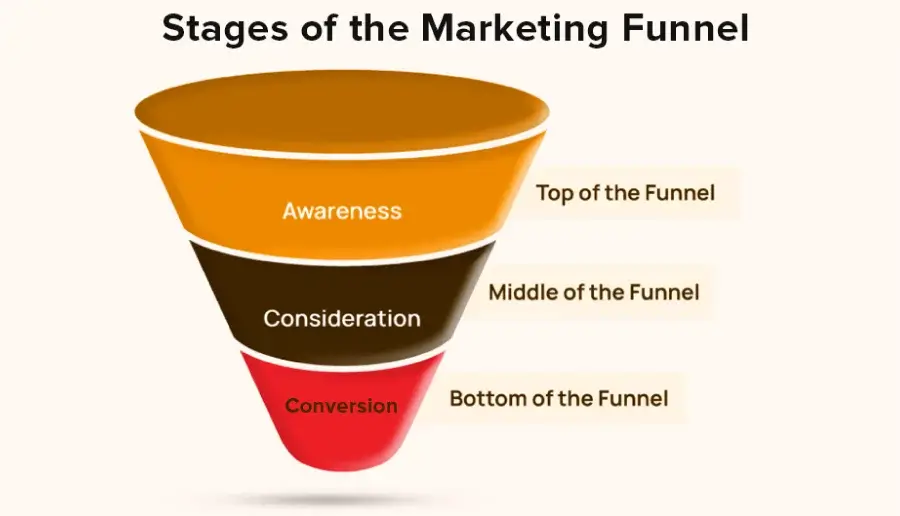
1. Awareness
At this initial stage, the goal is to introduce potential customers to your brand. Building brand awareness involves showcasing your brand’s identity, values, and offerings.
Effective channels for this include television, digital advertising, social media campaigns, and content marketing. Notably, the majority of shoppers begin their product searches on digital platforms outside a brand’s own website, emphasizing the importance of a strong online presence.
2. Consideration
Here, consumers are evaluating different options to meet their needs. Brands should focus on highlighting their unique value propositions, addressing customer pain points, and providing informative content.
Tools like customer testimonials, case studies, and webinars can be instrumental. Amazon Ads offers solutions such as Sponsored Brands and video/display ads through Amazon DSP to engage customers actively researching products.
3. Conversion
This stage aims to turn interested prospects into paying customers. It’s crucial to provide a seamless purchasing experience, detailed product information, and exceptional customer service. While tracking conversions can be straightforward through metrics like click-through rates and sales, it’s essential to recognize that earlier interactions in the funnel significantly influence purchasing decisions.
What is Full-Funnel Marketing?
Full-funnel marketing is a holistic approach that addresses every stage of the customer journey. Recognizing that consumers don’t follow a straight path to purchase, this strategy ensures consistent engagement, from initial awareness to post-purchase interactions.
Importance of Full-Funnel Marketing
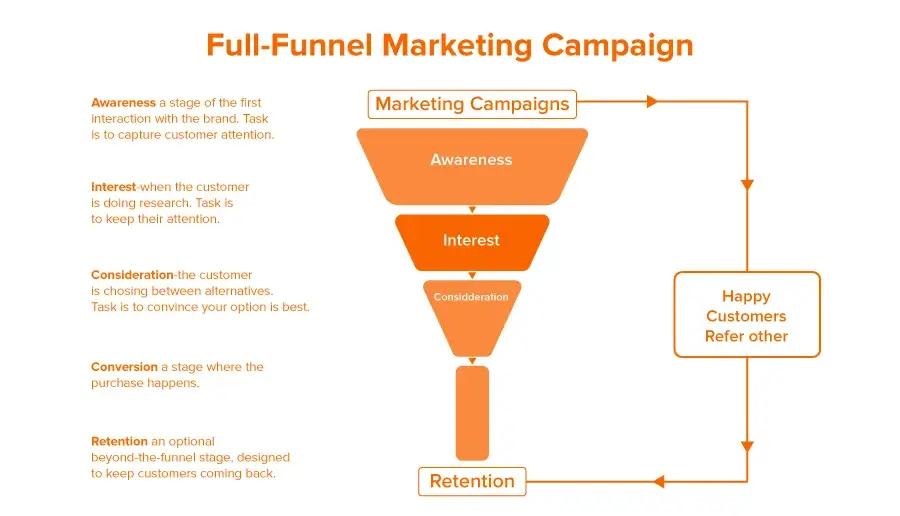
Given the non-linear nature of modern shopping behaviors, it’s imperative for brands to maintain a presence across all funnel stages. Upper-funnel strategies focus on brand awareness, mid-funnel tactics aim to build consideration, and lower-funnel efforts drive conversions. By integrating these strategies, brands can effectively guide consumers through their purchasing journey.
What is Amazon Demand Side Platform (DSP)?

Amazon DSP is a programmable advertising tool that enables advertisers to reach audiences both on and off Amazon. Unlike traditional PPC ads that target specific search terms, Amazon DSP leverages audience insights based on browsing behaviors, purchase history, and more. This makes it a powerful tool for engaging customers at various stages of the Amazon DSP funnel.
Check out this insightful conversation for practical advice on growing your business with Amazon DSP.
Key Features of Amazon DSP Funnel
- Audience-Based Targeting: Utilize Amazon’s rich customer data to target specific audience segments.
- Diverse Ad Formats: Run display, video, and audio ads across Amazon-owned platforms and third-party sites.
- Comprehensive Reach: Engage customers on platforms like Twitch, IMDb, Fire TV, and more.
- Flexible Access: Available through Amazon’s managed services, tech partners, or specialized agencies.
Leveraging Amazon DSP Funnel for Full-Funnel Marketing
Amazon DSP campaign funnel allows brands to connect with customers throughout their journey.
Top of Funnel: Building Awareness
At this stage of the Amazon DSP funnel, the objective is to introduce your brand to potential customers. Amazon DSP facilitates this by targeting broad audience segments based on demographics, interests, and behaviors. Utilizing display and video ads across Amazon’s network and third-party sites can effectively increase brand visibility.
Middle of Funnel: Driving Consideration
Here, the focus is on engaging customers who are evaluating their options. Amazon DSP advertising allows for retargeting users who have interacted with your brand or similar products, keeping your offerings top-of-mind as they continue their research.
Bottom of Funnel: Encouraging Conversion
At the conversion stage of the Amazon DSP funnel, it’s crucial to prompt decisive action. Amazon DSP advertising enables targeting of high-intent shoppers, such as those who have viewed product detail pages or added items to their cart. Dynamic retargeting ads can showcase specific products, nudging customers toward completing their purchase.
Post-Purchase: Fostering Loyalty
After a sale, maintaining engagement is key. Amazon DSP campaign funnel can be used to promote complementary products, encourage repeat purchases, or introduce new offerings. By excluding recent buyers from certain campaigns, brands can ensure messaging remains relevant and effective.
Where do Amazon DSP Ads Show
Amazon DSP ads can appear across a variety of platforms, including:
- Amazon-Owned Platforms: Prime Video, Amazon Freevee, Twitch, IMDb, Fire TV, Kindle, and Alexa devices.
- Third-Party Sites and Apps: Through Amazon Publisher Direct (APD) and leading third-party exchanges, ads can reach audiences on thousands of premium websites and applications.
Here’s an example Amazon DSP ad appearing on streaming platform Twitch:

Source: Amazon
Amazon DSP Ad Types

To effectively move shoppers through the Amazon DSP customer journey, it’s important to understand the different ad types available in the Amazon DSP funnel. These ad formats help brands build awareness, drive consideration, and convert customers across every stage of the Amazon DSP campaign funnel.
Display Ads
There are three main types of Display Ads available in Amazon DSP advertising:
- Website and Mobile Display Ads: These ads show up on desktop websites and mobile web pages. They come in seven different sizes, giving you flexibility in how your message is seen across devices.
- Mobile App & Banner Ads: These appear in apps on Android, Fire Tablet, and iOS devices. They come in four formats, mostly banner-shaped. Some ads can even include rich media like sound or video, but only on third-party sites, not on Amazon itself.
- Mobile Interstitial Ads: These full-screen ads pop up inside mobile apps and take over the screen briefly. Users can close them by tapping the “X” button. They’re great for capturing attention at a key moment in the Amazon DSP customer journey.
Video Ads
Video ads are a powerful tool in the Amazon DSP campaign funnel, especially for storytelling and brand engagement. With Amazon DSP, you can run both online video and streaming TV ads.
- OTT (Over-The-Top) Video Ads: These ads play before, during, or after streaming TV content. Since many OTT ads can’t be skipped, they’re often watched all the way through. You’ll find them on platforms like IMDb TV, during live sports like Thursday Night Football, and on Fire TV apps.
- Online Video Ads (Outstream): These are short video clips that show up while people are browsing websites, not while watching a video. They’re part of Amazon’s display ad formats and are great for awareness and mid-funnel engagement.
Pro tip: Include a clear CTA, since viewers have a short window to engage.
These ad types are all key elements of a successful Amazon DSP funnel strategy. Together, they help brands reach and influence audiences at every stage of the DSP advertising journey.
Amazon DSP vs. Sponsored Ads
How does Amazon DSP advertising differ from the more widely used Sponsored Ads on Amazon?
Sponsored Ads include Sponsored Products, Sponsored Brands, and Sponsored Display Ads, each targeting different stages of the customer journey. These ads mostly follow a pay-per-click (PPC) model based on keyword bidding and appear mainly on Amazon’s platform to capture shoppers actively searching for related products.
In contrast, Amazon DSP funnel offers a full-funnel, audience-based advertising solution, reaching customers at every stage of their journey: awareness, consideration, conversion, and post-purchase loyalty. It uses Amazon’s extensive first-party data to enable precise targeting through multiple options:

- Behavioral Targeting: Based on recent browsing or purchasing behavior.
- Lifestyle: Grouped by shared interests or habits.
- Contextual: Browsing content related to your product category.
- Remarketing: Re-engaging users who viewed or added products to their cart.
- Audience Lookalike: Finding new users similar to your existing or competitor’s audience.
- Advertiser Audiences: Using your own data (email lists, pixels) for custom targeting.
Unlike Sponsored Ads, Amazon DSP is priced on impressions (CPM), not clicks. This model allows for broader brand visibility and awareness-building campaigns.
Another major advantage of DSP is its vast ad inventory, reaching users across Amazon-owned platforms and external sites, mobile apps, Fire TV, and Twitch, making it more far-reaching than Sponsored Ads. DSP also supports audio ads, a format unavailable through Sponsored Ads.
Finally, eligibility differs: Sponsored Ads require you to be a registered Amazon seller with Brand Registry, while Amazon DSP is open to all advertisers, even those not selling on Amazon.
Check out our guide to learn more about Amazon Sponsored Ads.
10 Strategies for Amazon DSP Full-Funnel Success
Effectively navigating the Amazon DSP funnel requires more than just setting up ads; it demands a carefully planned strategy that aligns with each stage of the customer journey. Below are ten proven strategies to help advertisers harness the full power of Amazon DSP and drive success across the funnel.
1. Initiate with Retargeting
Retargeting is often the most efficient starting point for brands new to Amazon DSP. These campaigns focus on users who have already engaged with your brand, whether they visited a product detail page, added an item to their cart, or browsed related items. Because these users have demonstrated intent, they are more likely to convert, making retargeting an ideal low-risk entry point.
By launching with retargeting, advertisers can quickly generate ROI, collect performance data, and gain insights into what creative and messaging strategies resonate best with their audience. This information can then inform upper-funnel tactics as the campaign expands.
2. Leverage Amazon’s First-Party Data
Amazon has one of the most powerful data ecosystems in e-commerce, with insights into user behavior both on and off its platform. This includes browsing history, purchase behavior, product searches, and even content consumption on platforms like Fire TV and Twitch.
With Amazon DSP, advertisers can tap into this data to create hyper-targeted campaigns based on shopping behavior, interests, brand affinity, and even past purchases. This type of precision ensures your ads reach the right users at the right time, greatly improving relevance and performance.
3. Define Clear Goals for Each Funnel Stage
Full-funnel marketing only works when each phase has distinct, measurable goals. For the awareness stage, the goal might be to increase unique impressions or video views.
In the consideration stage, success could be measured by increased product detail page views or time spent engaging with branded content.
In the conversion phase, metrics like click-through rate (CTR), return on ad spend (ROAS), and completed purchases become paramount.
Setting clear KPIs helps in aligning campaign structure, creative messaging, and bidding strategies. It also makes it easier to analyze performance and optimize each stage independently.
4. Customize Creative Content for Each Funnel Stage
The messaging and visual design of your ads should reflect the customer’s position in the buying journey. For instance, awareness-stage ads should focus on brand identity, lifestyle appeal, and generating curiosity. Use emotionally engaging language and highlight your brand’s mission or unique selling proposition.
During the consideration phase, get more specific and highlight product features, benefits, and differentiators. Include trust elements like reviews, star ratings, or user testimonials. At the conversion stage, use urgency-inducing language like “limited time offer” to prompt immediate action.
5. Select Appropriate Ad Formats for Each Funnel Stage
Different stages of the funnel demand different ad formats. Top-of-funnel awareness campaigns benefit from visually compelling formats like video and animated display ads that can tell a brand story or introduce a new product. In the middle funnel, static display ads with persuasive copy and product benefits work well for educating and reminding audiences.
For lower-funnel campaigns, especially retargeting, dynamic display ads that show recently viewed or abandoned products can nudge users back to complete their purchase. The key is to match the format to the user’s mindset, so use storytelling early and conversion-focused messaging later.
6. Exclude Recent Buyers from Awareness Campaigns
While retargeting recent visitors can drive conversions, it’s important to exclude customers who have already purchased your product from upper-funnel campaigns. Serving awareness or consideration ads to these users wastes budget and may lead to customer fatigue or confusion.
Instead, these users can be placed in a loyalty campaign targeting them with ads for complementary products or upcoming launches. By managing exclusions effectively, you maintain ad relevance and improve return on investment.
7. Go Beyond Amazon’s Ecosystem
One of Amazon DSP’s biggest advantages over Sponsored Ads is its reach beyond the Amazon marketplace. Through Amazon Publisher Services and third-party exchanges, you can serve ads on thousands of premium websites and mobile apps, allowing you to meet customers wherever they are online.
This is especially powerful for top and mid-funnel strategies, where you’re targeting audiences who may not be actively shopping on Amazon but who fit your ideal customer profile. By expanding beyond the Amazon ecosystem, you can build brand recognition and drive consideration in entirely new contexts.
8. Conduct Ongoing A/B Testing
A/B testing is essential to optimizing your Amazon DSP campaigns over time. Test different versions of ad creatives, headlines, calls-to-action, images, and even audience segments to see what yields the best performance.
For example, you might test whether a lifestyle image performs better than a plain product image in the awareness stage, or whether including a customer review in the ad copy increases click-throughs. Amazon DSP’s reporting tools allow you to track performance at a granular level, making it easy to iterate and improve.
9. Use Frequency Capping to Avoid Oversaturation
Bombarding users with too many impressions in a short time frame can backfire. It leads to banner blindness, irritation, or even negative brand associations. Amazon DSP allows advertisers to set frequency caps, ensuring users see your ad a limited number of times per day or week.
This not only protects the user experience but also allows you to stretch your ad budget further and increase reach across your target audience. Proper frequency capping can also provide more accurate performance data, as it reduces skew caused by ad fatigue.
10. Analyze Funnel-Specific Metrics and Optimize Accordingly
Each stage of the Amazon DSP funnel has distinct success metrics, and it’s essential to measure performance with the right KPIs in mind. Top-funnel metrics include impressions, video completion rate, reach, frequency, and viewability. Mid-funnel performance is gauged by engagement metrics like detail page views, CTR, and add-to-cart or ad-to-list actions. Bottom-funnel success hinges on conversion rate, ROAS, and total sales.
Don’t make the mistake of judging an awareness campaign solely on direct conversions. Use attribution models and multi-touch reporting to understand how each campaign contributes to the broader journey. This approach provides a complete picture of campaign performance and guides more strategic budget allocation.
Also Read: The Ultimate Guide to Amazon PPC Metrics: What Every Seller Should Track
Final Thoughts
Learning how to use the Amazon DSP funnel helps brands connect with shoppers at every stage, from first discovering a product to making a purchase and becoming repeat customers.
By adding Amazon DSP’s smart targeting tools into your full-funnel ad plan, you can reach the right people at just the right time. This means more clicks, better sales, and stronger customer loyalty.
Whether you want to grow brand awareness or bring back people who’ve already shown interest, using the Amazon DSP campaign funnel is a smart way to get more from your digital ads.
Got More Questions?
Amazon DSP (Demand-Side Platform) provides three primary categories for audience targeting:
- Amazon Audiences: These are built using Amazon’s own first-party data, including customer buying behavior, browsing history, and streaming activities.
- Advertiser Audiences: These are custom audiences created by advertisers themselves, often based on specific product relevance or remarketing efforts (targeting users who have previously interacted with their brand).
- Third-Party Audiences: These audiences are compiled from broader internet activities, encompassing data, for instance, recent car purchases or cable subscriptions, sourced from external providers.
Campaign reports show you standard advertising numbers and special Amazon-only numbers. These Amazon-specific numbers include how often people view your product’s page (detail page view rate), how many times your product is added to a wish list or similar (add-to-list counts), and how many sales come from new customers (new-to-brand metrics). You’ll also see how many people saw your ad (reach), how often they saw it (frequency), and if it was actually visible to them (viewability).
You can run display ads (static and dynamic), video ads, and audio ads across Amazon-owned sites (like IMDb and Twitch) and third-party websites/apps.
The minimum spend for Amazon DSP varies depending on whether you choose the self-serve or managed service option. The self-serve option may cost around $12000-$15000 per month, while for the managed-service option, the minimum spend is $50,000. However, this minimum may vary by country.
Amazon DSP helps you reach high-intent shoppers with precise targeting, retarget customers across the web, run full-funnel campaigns, and access exclusive Amazon audience data you can’t get anywhere else.

